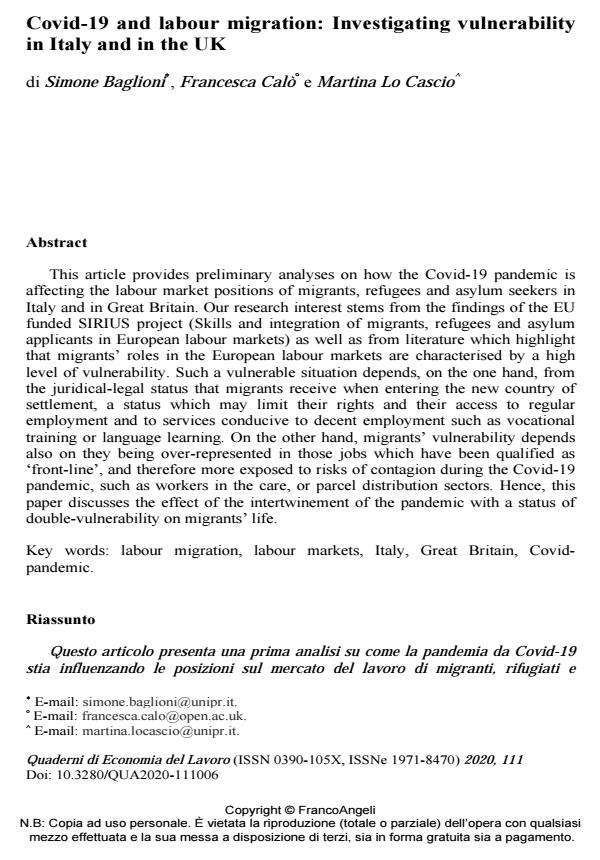Covid-19 and labour migration: Investigating vulnerability in Italy and in the UK
Titolo Rivista QUADERNI DI ECONOMIA DEL LAVORO
Autori/Curatori Simone Baglioni, Francesca Calò, Martina Lo Cascio
Anno di pubblicazione 2021 Fascicolo 2020/111
Lingua Inglese Numero pagine 21 P. 109-129 Dimensione file 232 KB
DOI 10.3280/QUA2020-111006
Il DOI è il codice a barre della proprietà intellettuale: per saperne di più
clicca qui
Qui sotto puoi vedere in anteprima la prima pagina di questo articolo.
Se questo articolo ti interessa, lo puoi acquistare (e scaricare in formato pdf) seguendo le facili indicazioni per acquistare il download credit. Acquista Download Credits per scaricare questo Articolo in formato PDF

FrancoAngeli è membro della Publishers International Linking Association, Inc (PILA)associazione indipendente e non profit per facilitare (attraverso i servizi tecnologici implementati da CrossRef.org) l’accesso degli studiosi ai contenuti digitali nelle pubblicazioni professionali e scientifiche
This article provides preliminary analyses on how the Covid-19 pandemic is affecting the labour market positions of migrants, refugees and asylum seekers in Italy and in Great Britain. Our research interest stems from the findings of the EU funded SIRIUS project (Skills and integration of migrants, refugees and asylum applicants in European labour markets) as well as from literature which highlight that migrants’ roles in the European labour markets are characterised by a high level of vulnerability. Such a vulnerable situation depends, on the one hand, from the juridical-legal status that migrants receive when entering the new country of settlement, a status which may limit their rights and their access to regular employment and to services conducive to decent employment such as vocational training or language learning. On the other hand, migrants’ vulnerability depends also on they being over-represented in those jobs which have been qualified as ‘front-line’, and therefore more exposed to risks of contagion during the Covid-19 pandemic, such as workers in the care, or parcel distribution sectors. Hence, this paper discusses the effect of the intertwinement of the pandemic with a status of double-vulnerability on migrants’ life.
Questo articolo presenta una prima analisi su come la pandemia da Covid-19 stia influenzando le posizioni sul mercato del lavoro di migranti, rifugiati e richiedenti asilo in Italia e in Gran Bretagna. Il nostro interesse di ricerca sul tema si basa sui risultati del progetto europeo SIRIUS ("Competenze e integrazione di migranti, rifugiati e richiedenti asilo nei mercati del lavoro europei"), nonché dalla letteratura che evidenzia come i ruoli dei migranti nei mercati del lavoro europei siano caratterizzati da un alto livello di vulnerabilità. Tale situazione di vulnerabilità dipende, da un lato, dallo status giuridico-legale che i migranti ricevono quando entrano nel nuovo paese di insediamento, uno status che può limitare i loro diritti e il loro accesso a un’occupazione regolare e a servizi favorevoli a un’occupazione dignitosa come l’accesso alla formazione professionale o l’apprendimento della lingua. D’altra parte, la vulnerabilità dei migranti dipende anche dal fatto che siano sovrarappresentati in quei lavori che sono stati qualificati come in ‘prima linea’, e quindi più esposti ai rischi di contagio durante la pandemia Covid-19, come i lavoratori nella cura o nella distribuzione di pacchi. Dunque questo articolo discute l’effetto sulla vita dei migranti provocato dall’intreccio della pandemia con uno status di doppia vulnerabilità.
Parole chiave:Lavoro migrante, mercati del lavoro, Italia, Gran Bretagna, pandemia da Covid-19
Simone Baglioni, Francesca Calò, Martina Lo Cascio, Covid-19 and labour migration: Investigating vulnerability in Italy and in the UK in "QUADERNI DI ECONOMIA DEL LAVORO" 111/2020, pp 109-129, DOI: 10.3280/QUA2020-111006